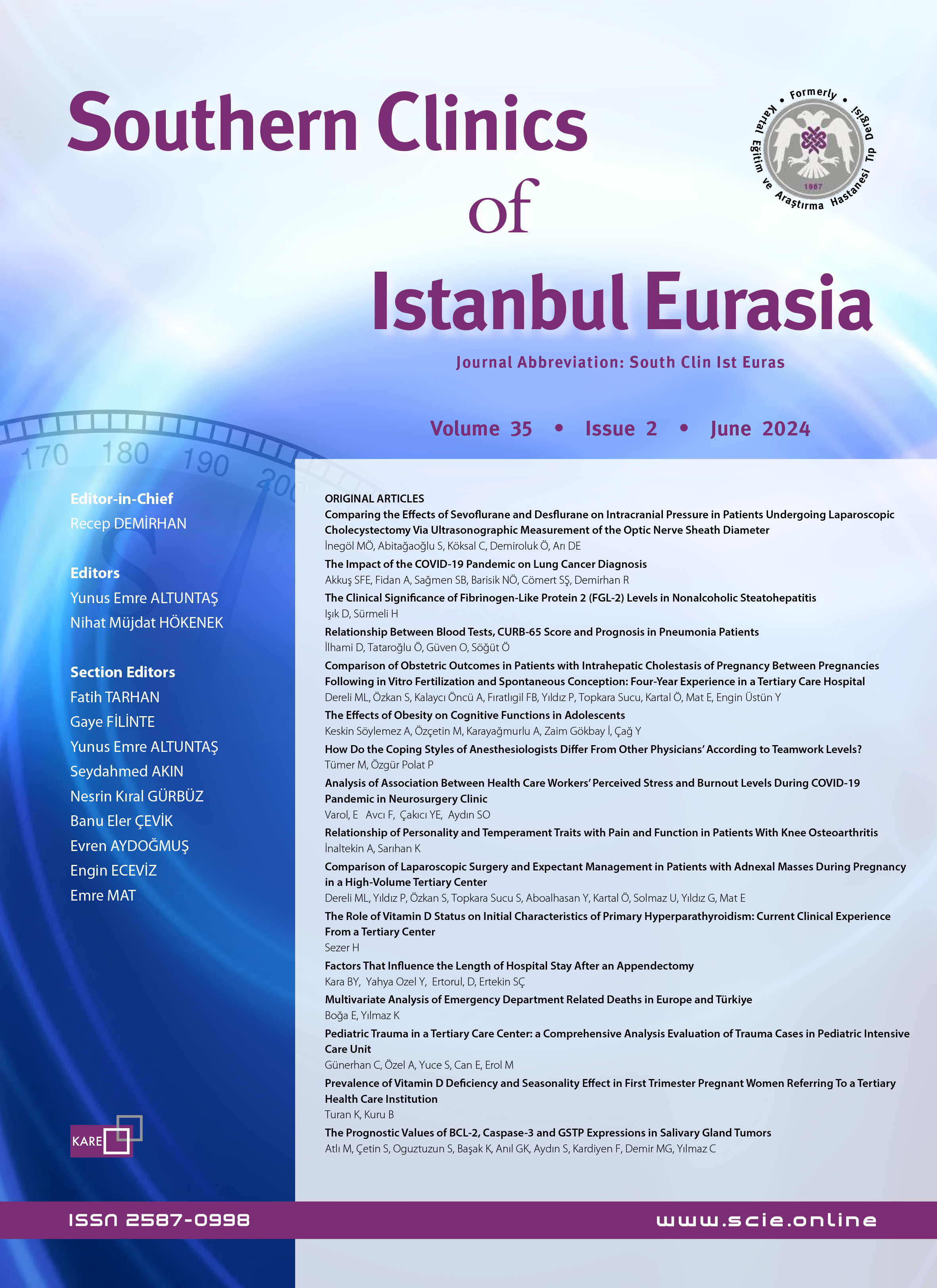Volume: 19 Issue: 3 - 2008
| RESEARCH ARTICLE | |
| 1. | Retrospective analysis of aspiration pneumonia cases Ali Fidan, Sevda Şener Cömert, Muharrem Tokmak, Gülşen Saraç, Banu Salepçi, Nesrin Kıral Pages 113 - 116 OBJECTIVE: We aimed to evaluate the demographic, clinical and laboratory findings of aspiration pneumonia (AP) cases who were hospitalized in our clinic. METHODS: Records of 31 AP cases hospitalized in our clinic between 2002 and 2008 were retrospectively analyzed. RESULTS: Seventeen (54.8%) male and 14 (45.2%) female patients were included in the study. Of the cases, 22 (71.0%) occurred at home, 6 (19.4%) in other departments of the hospital and 3 (9.6%) in a nursing home. The most frequent symptom was dyspnea (93.5%), followed by sputum production (83.9%), cough (67.7%) and fever (58.1%). Neurological problems were seen in 17 (45.2%) as a predisposing factor, while no predisposing factor was found in 9 (29.0%) patients. In 8 (25.8%) patients, the aspiration was witnessed. Chest X-rays showed bilateral involvement in 48.4% of patients. Most of the unilaterally involved patients had right-sided lesion (81.2%). Leukocytosis was present in 20, hypoxemia in 18 and hypotension in 5 patients. Of all cases, 16 (51.6%) were discharged after treatment, while 9 patients required transfer to the intensive care unit (ICU) and 6 patients died. When compared to those who were discharged, deceased patients and those transferred to the ICU had significantly more frequent hypotension (0% vs 33.3%, respectively, p=0.018). PaO2 was higher and urea level was lower in discharged patients, but without statistical significance (p>0.05). CONCLUSION: In the presence of neurological problems, more attention should be given to aspiration, and if it progresses to an aspiration pneumonia, hypoxemia, urea level and especially hypotension should be monitored as predictors of poor prognosis. |
| 2. | Bronchial challenge test and related factors in the presence of asthma and/or allergic rhinitis symptoms Sevda Şener Cömert, Ali Fidan, Nesrin Kıral, Gülşen Saraç, Banu Salepçi Pages 117 - 122 OBJECTIVE: Although bronchial hyperresponsiveness is one of the main features of asthma, its presence is thought to be important in allergic rhinitis. Bronchial challenge test (BCT) is a procedure used in the differential diagnosis of symptoms related to these diseases. The aim of this study was to determine the BCTs performed in our clinic and factors related to their results. METHODS: The records of 67 patients who underwent BCT in our clinic in 2008 were retrospectively analyzed. Their demographic properties, pulmonary function tests, skin prick tests, peripheral eosinophilia, and total IgE levels were recorded and compared with BCT results. Chi-square and correlation tests were used in statistical analysis. RESULTS: The mean age was 34.4±13.4; 23 (34.3%) were male and 44 (65.7%) were female. Dyspnea and chronic cough were equal in frequency and were the leading symptoms (n=43, 64.2%), followed by wheezing (n=28, 41.8%) and sneezing (n=20, 29.9%). BCT was found to be positive in 13 (19.4%) of the cases. BCT positivity was correlated with skin prick test positivity (r=0.454, p<0.001) and peripheral eosinophilia (r=0.497, p=0.014), while there was no correlation with age, gender, forced vital capacity (FVC), forced expiratory volume in 1 second (FEV1), peak expiratory flow (PEF) and total IgE levels. There was also no relationship between BCT positivity and the presence of dyspnea or chronic cough, while a statistically significant relationship was found between BCT positivity and presence of wheezing (p=0.006) or sneezing-nasal discharge (p=0.005). CONCLUSION: Bronchial hyperreactivity must be considered not only in bronchial asthma but also in the presence of allergy and rhinitis. |
| 3. | Giant skin and soft tissue cancers Aykut Mısırlıoğlu, Hüseyin Karanfil, Tayfun Aköz Pages 123 - 130 OBJECTIVE: In the human body, most tumors originate from skin and soft tissues. Giant skin and soft tissue tumors cause significant morbidity and mortality and they may also affect important anatomical structures. In this study, we examined the clinical presentations, diagnoses, pathological types, and treatment approaches for giant skin and soft tissue tumors. METHODS: This study included 18 patients with tumor sizes greater than 15 cm who were identified during a retrospective evaluation of 1016 cases with skin and soft tissue cancer. Lesions were removed using wide resection and treated with complex reconstructive procedures. Patients were followed up to five years. RESULTS: Three cancer types were identified: eight cases with squamous cell cancer; five cases with sarcoma; and five cases with basal cell cancer. Cases with basal cell cancer had the best survival and cases with sarcomas had the worst. CONCLUSION: The surgical approach is very difficult in giant tumors due to their characteristically high morbidity and mortality. Tumor size is an important factor for survival in squamous cell cancers and sarcomas. Although surgery improves quality of life in these patients, it is only a palliative approach. Nevertheless, results are better in cases with basal cell cancer, and curative surgery is sometimes possible. |
| 4. | Cases with familial Mediterranean fever Gülay Çiler Erdağ, Yasemin Akın, Turgut Ağzıkuru, Recep Yaver, Semiramis Sadıkoğlu, Ayça Vitrinel Pages 131 - 137 OBJECTIVE: We planned to investigate the types of the genetical mutations, the relationship between mutation analysis and disease severity score and the regional distribution of our patients who were clinically diagnosed as FMF, that were genetically analyzed. METHODS: Thirty-seven patients admitted to our department with various non-specific symptoms and diagnosed as FMF between 2004-2008 were included in this study. The medical records of the patients were evaluated retrospectively. RESULTS: The mean age of the patients was 10.35±3.4 years. The most common complaints were abdominal pain (100%) and fever (89%). The results of the genetic analysis revealed that M694V (50%), E148Q (13.8%), M680I (11.1%) and V726A (2.72%) were the most common mutations. Regarding the relationship between the disease severity score and the mutational analysis, the highest scores were those of M694V homozygote (8.25), M694V/N heterozygote (6.6) and M694V-M680I heterozygote (5.6) mutations. CONCLUSION: Although the clinical features do not support an exact diagnosis, in any case of suspicion, FMF should be genetically analyzed particularly in a country with high incidence of FMF like in Turkey. MEFV gene mutations are frequently seen in our society and discovering their relations with clinical and demographic findings will help in the diagnosis and tracking of the patients with FMF. |
| 5. | C-reactive protein and internal carotid artery thickness in acute ischemic stroke Yeliz Şengül, Semra Bilge, Fazilet Hız, Ülgen Kökeş, Meral Çınar, Turgut Karagöl Pages 138 - 143 OBJECTIVE: In this study, C-reactive protein (CRP) and intima-media thickness (IMT) were investigated in 40 patients with acute ischemic stroke and 30 subjects representing a control group. METHODS: In acute ischemic stroke, CRP and IMT levels were measured in the first 24 hours. RESULTS: IMT and CRP values were higher than in controls. There was a statistically significantly positive relationship between IMT-CRP/IMT-age (p=0.0001). No significant relationship was determined between IMT, CRP and gender. There was also no relationship between plaque formation and IMT and CRP. The possibility of having ischemic stroke with IMT >1.2 was 2.82 times greater than with IMT <1.2. CRP was not helpful in the differential ischemic stroke diagnosis. CRP was found to be significantly high in major infarct. CRP in anterior cerebral artery (ACA) stroke patients was lower than in the patients with MCA and PCA stroke. CONCLUSION: In this study, after diagnosis of ischemic stroke, CRP was too much an important indicator to IMT by the violence and localization of the disease. CRP was an important risk factor in acute ischemic stroke and there was a parallel positive relationship between an increase in IMT and CRP. |
| CASE REPORT | |
| 6. | Microscopic polyangiitis: Case report Sevda Şener Cömert, Nesrin Kıral, Ali Fidan, Gülşen Saraç, Banu Salepçi, Benan Çağlayan Pages 144 - 147 Microscopic polyangiitis is a systemic, nongranulomatous, small vessel disease involving the lung, kidney and skin. The disease is characterized by the presence of ANCA, crescentic glomerulonephritis, pulmonary capillaritis, and no immune deposits in the involved vessels. Some cases may present with alveolar hemorrhage. We reviewed the different features of microscopic polyangiitis due to our case who presented with gastrointestinal bleeding, hemoptysis and skin lesions. |
| LETTER TO EDITOR | |
| 7. | Uniform requirements for manuscripts submitted to biomedical journals: Writing and editing for biomedical publication Pages 148 - 164 Abstract | |



















